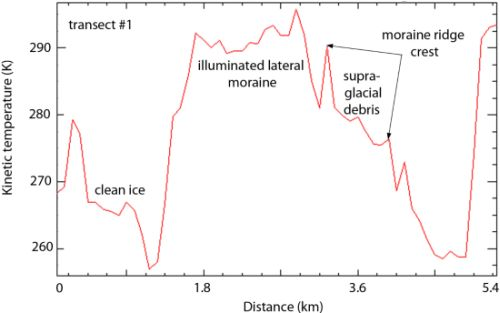Decision Tree and Texture Analysis for Mapping Debris-Covered Glaciers in the Kangchenjunga Area, Eastern Himalaya
Abstract
:1. Introduction
2. Study Area
3. Data Sources and Methodology
3.1. Data Sources
3.2. Topographic and Multi-Spectral Analysis
3.3. Texture Measures
4. Results and Discussion
4.1. Clean Ice/Snow
4.2. Thermal Analysis Results
4.3. Decision Tree Results
- Clean ice and snow were delineated using the NDSI algorithm with a threshold of 0.7 (NDSI > 0.7 = snow/ice), as described in Section 4.1 above. Distinguishing snow from ice was not possible with NDSI alone, but both categories were excluded from potential debris at this step in the analysis.
- Clouds had a similar spectral response to ice in the visible bands (ASTER 1 and 2 in particular), but their reflectivity decreased at mid IR wavelengths. Band 4 of ASTER with a threshold of 90 successfully mapped all clouds (band 4 > 90 = clouds). However, we noted that some pixels corresponding bright moraine edges were inadequately mapped as clouds.
- Vegetation was mapped using the NDVI method with a threshold of 0.05 (NDVI < 0.05 = vegetation). The same threshold was obtained in a study conducted in the Alps [44]. Caution was exercised in choosing this threshold, because it is known that sparse vegetation can grow on some parts of the termini, covered with stagnant ice [32]. Some authors, for example, used the presence of vegetation on some parts of the debris-covered tongues during the spring time in the Kanchenjunga area as an indicator of debris to aid in the remote sensing mapping [78]. NDVI and slope variables were found to be two of the most important variables in predicting potential locations for rock glaciers in a different study [79].
- Shadows were delineated using ASTER band 3 with a threshold of 25 (band 3n < 25 = shadows). We note that shadows may occur over the debris-covered areas as well. However, the detection of debris-covered areas is not possible in areas of deep shadows anyway, unless the algorithm relies in big part on morphologic characteristics as pointed out in a few studies [32,36]. We included the shadow areas with a low threshold to exclude small, deep shadows that introduce too much noise in the final map.
- The HSV image generated from ASTER bands 2, 3 and 5 was useful for excluding bare rock and sand (including illuminated moraine) on the northern sides of the debris-covered tongues such as Zemu, using a threshold of 200 (Hue < 200 = periglacial moraine). Paul et al. [31] used the HSV image with a threshold of 126 to successfully map vegetated areas, which were then excluded from the potential debris-covered areas.
- Slope angle was calculated in GIS based on the ASTER DEM. Statistics showed that the slopes of the debris-covered areas ranged between 0 and 14 degrees. We chose a maximum value of 12 degrees in agreement with a previous studies [32], which showed that many debris cover tongues can be captured using this slope threshold. Another study, conducted in the Alps [31] used a much higher slope threshold of 24 degrees in their classification. However, we found that a higher slope threshold at this particular pixel size (30 m) included a lot of the steep slopes and rock walls with talus sheds, and were not suitable for the accumulation of debris.
- The temperature range was chosen based on bands 10 and 12 of ASTER following various experiments with all the thermal bands (section 4.2 above). Thresholding these two bands (band 10 > 70 K and band 12 < 90 K) captured most debris-covered tongues identified on the topographic map.
- Elevations outside the 4,000 m–5,600 m range were excluded from the map of potential debris-covered areas. The values are based on observations elsewhere in the Himalaya, which showed that the termini of debris-covered glaciers are generally situated between 4,000 and 5,000 m [30]. Modern ELA values were estimated to be 5,000–6,000 m in the Kangchenjunga area [79]. In a different study, we calculated a regional ELA value of ∼5,400 m for the Langtang Himalaya (in the same climatic zone as Kanchenjunga) based on ASTER imagery at the end of the ablation season [80]. The ELA was determined to be higher for debris-covered glaciers than clean glaciers for Nepal glaciers in the same climatic zone [81]. On the basis of these observations, we chose a slightly higher upper limit for the potential debris cover (5,600 m compared to 5,400 m estimated for Langtang), to minimize any exclusion of debris pixels higher in the ablation zone of glaciers.
4.3.1. Validation of the Decision Tree with High-Resolution Imagery
4.4. Texture Analysis Results
4.4.1. Grey-Level Co-Occurrence Measures
4.4.2. Filtering in Spatial and Frequency Domain
4.4.3. Geostatistics as a Texture Measure
4.4. Comparison of Texture Analysis with the Decision Tree Results
5. Uncertainty and Limitations
- Geolocation errors on the topographic map in the western part (Nepal) prevent an accurate assessment of the performance of the decision tree on these glacier tongues. Such errors are due to the use of different datums in this part of the world, most notably local datums (Everest 1956 or other), which introduce large errors when transformed to global datums (WGS84) [87].
- Profile curvature was shown to be important in previous studies to identify concavities in terrain, specific of debris-covered tongues [32,34,36,42]. Curvature was also found to be one of the most important predicting variables for debris-covered areas in other studies in the Andes [78,88]. In the current study, the profile and plan curvature calculated in GIS based on the ASTER DEM proved inconclusive in distinguishing debris-covered tongues from the surrounding terrain, as it produced noisy images. We estimate this to be caused by the noise inherent in the “relative” ASTER DEMs produced at LPDAAC, which lack post-processing steps such as terrain smoothing. Therefore, at this time, terrain curvature was not included in the decision tree.
- A quantitative assessment of the differences between the decision tree output and the old topographic map was not conducted, because of potential glacier changes that might have occurred since the 1960–1970s, and the unknown accuracy of the topographic map.
- Shadows over the debris-covered tongues remain a big problem in the delineation of these tongues. A more rigorous topographic analysis would be needed in order to capture all the debris-covered tongue independent of their degree of shadow.
- Snowfields outside the glacier caused an overestimation on the snow and ice area based on the NSDI, and had to be adjusted manually.
- Texture measures were not included in the decision tree due to the challenge of conducting texture classification and segmentation schemes. Supervised classification techniques have been used before as a visual clue to identify homogenous regions, with promising results [48]; however, these methods still require significant user input. More sophisticated methods such as structural methods, geometric methods or model-based methods also exist in other domains [46]. For debris-covered areas, we suggest that shape recognition techniques based on orientation or shading of objects may be useful to characterize the distribution of ice walls and supraglacial lakes on the texture surface. Geometrical methods such as the Voronoi polygons may also be useful for texture delimitation among regions, particularly the transition from debris cover to ice-free moraine. Voronoi polygons are areas with distinct shapes and texture derived based on texture tokens, i.e., points of high gradient or complex structure [47]. Such techniques have not yet yielded concluding results for our dataset, but will be explored in a future study.
6. Conclusions
Acknowledgments
References
- Nakawo, M.; Raymond, C.F.; Fountain, A. Debris-Covered Glaciers; IAHS Press: Wallingford, UK, 2000; p. 288. [Google Scholar]
- Shroder, J.F.; Bishop, M.P.; Copland, L.; Sloan, V. Debris-covered glaciers in the Nang Parbat Himalaya, Pakistan. Geogr. Ann 2000, 82A, 17–31. [Google Scholar]
- Bishop, M.P.; Kargel, J.S.; Kieffer, H.H.; MacKinnon, D.J.; Raup, B.H.; Shroder, J.F. Remote-sensing science and technology for studying glacier processes in high Asia. Ann. Glaciol 2000, 31, 164–170. [Google Scholar]
- Iwata, S.; Aoki, T.; Kadota, T.; Seko, K.; Yamaguchi, S. Morphological Evolution of the Debris Cover on Khumbu Glacier, Nepal, between 1978 and 1995. In Debris-Covered Glaciers; Nakawo, M., Raymond, C.F., Fountain, A., Eds.; IAHS: Wallingsford, UK, 2000; Volume 264, pp. 3–11. [Google Scholar]
- Benn, D.I.; Evans, D.J.A. Glaciers and Glaciations, 2nd ed.; Hodder Arnold: London,UK, 2010. [Google Scholar]
- Casey, K.A.; Kaab, A.; Benn, D.I. Characterization of glacier debris cover via in situ and optical remote sensing methods: A case study in the Khumbu Himalaya, Nepal. The Cryosphere Dicuss 2011, 5, 499–564. [Google Scholar]
- Nakawo, M.; Yabuki, H.; Sakai, A. Characteristics of Khumbu Glacier, Nepal Himalaya: Recent change in the debris-covered area. Ann. Glaciol. 1999, 28, 118–122. [Google Scholar]
- Conway, H.; Rasmussen, L.A.; Nakawo, M. Summer Temperature Profiles within Supraglacial Debris on Khumbu Glacier, Nepal. In Debris-Covered Glaciers; Nakawo, M., Raymond, C.F., Fountain, A., Eds.; IAHS: Wallingsford, UK, 2000; pp. 89–97. [Google Scholar]
- Gades, A.; Conway, H.; Nereson, N. Radio echo-sounding through supraglacial debris on Lirung and Khumbu glaciers, Nepal Himalayas. In Debris-Covered Glaciers; Nakawo, M., Raymond, C.F., Fountain, A., Eds.; IAHS: Wallingsford, UK, 2000; pp. 13–11. [Google Scholar]
- Foster, L.A.; Brock, B.W.; Cutler, M.E.J.; Diotri, F. A physically based method for estimating supraglacial debris thickness from thermal band remote-sensing data. J. Glaciol 2012, 58, 677–690. [Google Scholar]
- Mihalcea, C.; Mayer, C.; Diolaiuti, G.; D’Agata, C.; Smiraglia, C.; Lambrecht, A.; Vuillermoz, E.; Tartari, G. Spatial distribution of debris thickness and melting from remote-sensing and meteorological data, at debris-covered Baltoro glacier, Karakoram, Pakistan. Ann. Glaciol 2008, 48, 49–57. [Google Scholar]
- Bolch, T.; Buchroithner, M.F.; Peters, J.; Baessler, M.; Bajracharya, S. Identification of glacier motion and potentially dangerous glacial lakes in the Mt. Everest region/Nepal using spaceborne imagery. Nat. Hazards Earth Syst. Sci 2008, 8, 1329–1340. [Google Scholar]
- Mool, P.K.; Bajracharya, S.R.; Joshi, S.P.; Sakya, K.; Baidya, A. Inventory of Glaciers, Glacial Lakes and Glacial Lake Outburst Floods Monitoring and Early Warning Systems in the Hindu-Kush Himalayan Region, Nepal; International Center for Integrated Mountain Development: Kathmandu, Nepal, 2002; p. 227. [Google Scholar]
- Zhang, Y.; Fujita, K.; Liu, S.; Liu, Q.; Nuimura, T. Distribution of debris thickness and its effect on ice melt at Hailuogou glacier, southeastern Tibetan Plateau, using in situ surveys and ASTER imagery. J. Glaciol 2011, 57, 1147–1157. [Google Scholar]
- Mihalcea, C.E.; Brock, B.W.; Diolaiuti, G.A.; D’Agata, C.; Citterio, M.; Kirkbride, M.P.; Cutler, M.; Smiraglia, C. Using ASTER satellite and ground-based surface temperature measurements to derive supraglacial debris covere and thickness patterns on Miage Glacier (Mont Blanc Massif, Italy). Cold Reg. Sci. Technol 2008, 52, 341–354. [Google Scholar]
- Brock, B.W.; Mihalcea, C.; Kirkbride, M.P.; Diolaiuti, G.; Cutler, M.E.J.; Smiraglia, C. Meteorology and surface energy fluxes in the 2005–2007 ablation seasons at the Miage debris-covered glacier, Mont Blanc Massif, Italian Alps. J. Geophys. Res 2010, 115, D09106. [Google Scholar]
- Takeuchi, Y.; Kayastha, R.B.; Nakawo, M. Characteristics of Ablation and Heat Balance in Debris-Free and Debris-Covered Areas on Khumbu Glacier, Nepal Himalayas, in the Pre-Monsoon Season. In Debris-Covered Glaciers; Nakawo, M., Raymond, C.F., Fountain, A., Eds.; IAHS: Wallingsford, UK, 2000; pp. 53–61. [Google Scholar]
- Kayastha, R.B.; Takeuchi, Y.; Nakawo, M.; Ageta, Y. Practical Prediction of Ice Melting Beneath Various Thickness of Debris Cover on Khumbu Glacier, Nepal, Using a Positive Degree-Day Factor. In Debris-Covered Glaciers; Nakawo, M., Raymond, C.F., Fountain, A., Eds.; IAHS: Wallingford, UK, 2000; pp. 71–81. [Google Scholar]
- Singh, P.K.; Naresh, R.K.S.; Yatveer, S. Influence of a Fine Debris Layer on the Melting of Snow and Ice on a Himalayan Glacier. In Debris-Covered Glaciers; Nakawo, M., Raymond, C.F., Fountain, A., Eds.; IAHS: Wallingford, UK, 2000; pp. 63–69. [Google Scholar]
- Bolch, T.; Kulkarni, A.; Kääb, A.; Huggel, C.; Paul, F.; Cogley, J.G.; Frey, H.; Kargel, J.S.; Fujita, K.; Scheel, M.; et al. The state and fate of Himalayan glaciers. Science 2012, 336, 310–314. [Google Scholar]
- Bolch, T.; Buchroithner, M.F.; Pieczonka, T.; Kunert, A. Planimetric and volumetric glacier changes in the khumbu himalaya since 1962 using Corona, Landsat TM and ASTER Data. J. Glaciol 2008, 54, 592–600. [Google Scholar]
- Bolch, T.; Pieczonka, T.; Benn, D.I. Multi-decadal mass loss of glaciers in the Everest area (Nepal Himalaya) derived from stereo imagery. The Cryosphere 2011, 5, 349–358. [Google Scholar] [Green Version]
- Gardelle, J.; Berthier, E.; Arnaud, Y. Slight mass gain of Karakoram glaciers in the early twenty-first century. Nature Geosci, 2012. [Google Scholar] [CrossRef]
- Berthier, E.; Arnaud, Y.; Kumar, R.; Ahmad, S.; Wagnon, P.; Chevallier, P. Remote sensing estimates of glacier mass balances in the Himachal Pradesh (Western Himalaya, India). Remote Sens. Environ 2007, 108, 327–338. [Google Scholar] [Green Version]
- Paul, F.; Haeberli, W. Spatial variability of glacier elevation changes in the Swiss Alps obtained from two digital elevation models. Geoph. Res. Lett, 2008. [Google Scholar] [CrossRef]
- Smiraglia, C.; Diolaiuti, G.; Casati, D.; Kirkbride, M.P. Recent Areal and Altimetric Variations of Miage Glacier (Monte Bianco Massif, Italian Alps). In Debris-Covered Glaciers; Nakawo, M., Raymond, C.F., Fountain, A., Eds.; IAHS: Wallingford, UK, 2000; pp. 227–233. [Google Scholar]
- Hewitt, K. The Karakoram anomaly? Glacier expansion and the ‘elevation effect’, Karakoram Himalaya. Mou. Res. Dev 2005, 25, 332–340. [Google Scholar]
- Schmidt, S.; Nusser, M. Fluctuations of Raikot Glacier during the past 70 years: A case study from the Nanga Parbat massif, northern Pakistan. J. Glaciol 2009, 55, 949–959. [Google Scholar]
- Hewitt, K. Glacier change, concentration, and elevation effects in the Karakoram Himalaya, upper Indus Basin. Mou. Res. Dev 2011, 31, 188–200. [Google Scholar]
- Sakai, A.; Fujita, K. Correspondence: Formation conditions of supraglacial lakes on debris covered glaciers in the Himalaya. J. Glaciol 2010, 56, 177–181. [Google Scholar]
- Paul, F.; Huggel, C.; Kääb, A. Combining satellite multispectral image data and a digital elevation model for mapping debris-covered glaciers. Remote Sens. Environ 2004, 89, 510–518. [Google Scholar]
- Bolch, T.; Buchroithner, M.F.; Kunert, A.; Kamp, U. Automated Delineation of Debris-Covered Glaciers Based on ASTER Data. Proceedings of 27th EARSel Symposium, Bozen, Italy, 4–7 June 2007; pp. 403–410.
- Shukla, A.; Arora, M.K.; Gupta, R.P. Synergistic approach for mapping debris-covered glaciers using optical-thermal remote sensing data with inputs from geomorphometric parameters. Remote Sens. Environ 2010, 114, 1378–1387. [Google Scholar]
- Bishop, M.P.; Bonk, R.; Kamp, U.; Shroder, J.J.F. Terrain analysis and data modeling for alpine glacier mapping. Polar. Geogr 2001, 25, 182–201. [Google Scholar]
- Paul, F.; Kaab, A.; Maisch, M.; Kellenberger, T.; Haeberli, W. Rapid disintegration of Alpine glaciers observed with satellite data. Geophy. Res. Lett, 2004. [Google Scholar] [CrossRef]
- Bolch, T.; Kamp, U. Glacier mapping in high mountains using DEMs, Landsat and ASTER data. Grazer Scriften der Geographie und Raumforschung 2006, Band 41. 37–48. [Google Scholar]
- Bishop, M.P.; Bonk, R.; Kamp, U., Jr.; Shroder, J.F., Jr. Terrain analysis and data modeling for alpine glacier mapping. Polar Geogr 2001, 25, 182–201. [Google Scholar]
- Racoviteanu, A.; Paul, F.; Raup, B.; Khalsa, S.J.S.; Armstrong, R. Challenges and recommendations in mapping of glacier prameters from space: Results of the 2008 global land ice measurements frpom space (GLIMS) workshop, Boulder, Colorado, USA. Ann. Glaciol 2009, 50, 53–69. [Google Scholar]
- Paul, F.; Barrand, N.; Berthier, E.; Bolch, T.; Casey, K.; Frey, H.; Joshi, S.P.; Konovalov, V.; Bris, R.L.; Mölg, N.; et al. On the accuracy of glacier outlines derived from remote sensing data. Ann. Glaciol 2012, 54. in press.. [Google Scholar]
- Suzuki, R.; Fujita, K.; Ageta, Y. Spatial distribution of thermal properties on debris-covered glaciers in the Himalayas derived from ASTER data. Bull. Glacier. Res 2007, 24, 13–22. [Google Scholar]
- Racoviteanu, A.; Williams, M.W.; Barry, R. Optical remote sensing of glacier mass balance: A review with focus on the Himalaya. Sensors 2008, 8, 3355–3383. [Google Scholar]
- Kamp, U.; Byrne, M.; Bolch, T. Glacier fluctuations between 1975 and 2008 in the Greater Himalaya Range of Zanskar, southern Ladakh. J. Mou. Sci 2011, 8, 374–389. [Google Scholar]
- Shukla, A.; Gupta, R.P.; Arora, M.K. Estimation of debris cover and its temporal variation using optical satellite sensor data: A case study in Chenab basin, Himalaya. J. Glaciol 2009, 55, 444–452. [Google Scholar]
- Taschner, S.; Ranzi, R. Landsat-TM and ASTER Data for Monitoring a Debris Covered Glacier in the Italian Alps within the GLIMS Project. Proceedings of 2002 IEEE International Geoscience and Remote Sensing Symposium, Toronto, ON, Canada, 24– 28 June 2002; 4, pp. 1044–1046.
- Brenning, A.; Peña, M.A.; Long, S.; Soliman, A. Thermal remote sensing of ice-debris landforms using ASTER: An example from the Chilean Andes. The Cryosphere, 2012. [Google Scholar] [CrossRef]
- Nakawo, M.; Morohoshi, T.; Uehara, S. Satellite Data Utilization for Estimating Ablation of Debris Covered Glaciers. Proceedings of the Kathmandu Symposium, Kathmandu, Nepal, 16–21 November 1992; 218, pp. 75–83.
- Tuceryan, M.; Jain, A.K. Texture Analysis. In The Handbook of Pattern Recognision and Computer Vision, 2nd ed.; Chen, C.H., Pau, L.F., Wang, P.S.P., Eds.; World Scientific Publishing: Singapore, 1998; pp. 207–248. [Google Scholar]
- Chica-Olmo, M.; Abarca-Hernandez, F. Variogram Derived Image Texture for Classifying Remotely Sensed Images. In Remote Sensing Image Analysis: Including the Spatial Domain; de Jong, S.M., van der Meer, F.D., Eds.; Kluwer Academic Publishers: Dordrecht, The Netherlands, 2004; pp. 93–111. [Google Scholar]
- Rignot, E.; Kwok, R. Extraction of Textural Features in SAR Images: Statyistical Model and Sensitivity. Proceedings of 10th Annual International Geoscience and Remote Sensing Symposium, Washington, DC, USA, 20– 24 May 1990; pp. 1979–1982.
- Soares, J.V.; Rennó, C.D.; Formaggio, A.R.; Yanasse, C.D.F.; Frery, A.C. An investigation of the selection of texture features for crop discrimination using SAR imagery. Remote Sens. Environ 1997, 59, 234–247. [Google Scholar]
- Chamundeeswari, V.V.; Singh, D.; Singh, K. An analysis of texture measures in PCA-based unsupervised classification of SAR images. IEEE Trans. Geosci. Remote Sens 2009, 6, 214–218. [Google Scholar]
- Frey, H.; Paul, F.; Strozzi, T. Compilation of a glacier inventory for the western Himalayas from satellite data: Methods, challenges and results. Remote Sens. Environ 2012, 124, 832–843. [Google Scholar]
- Racoviteanu, A.; Williams, M.W.; Barry, R. Optical remote sensing of glacier mass balance: A review with focus on the Himalaya. Sensors 2008, 8, 3355–3383. [Google Scholar]
- Ageta, Y.; Higuchi, K. Estimation of mass balance components of a summer-accumulation type glacier in the nepal himalaya. Geogr. Ann. Ser. A-Phyl. Geogr 1984, 66, 249–255. [Google Scholar]
- Kaul, M.K.; Puri, V.M.K. Inventory of Himalayan Glaciers: A Contribution to the International Hydrological Programme; Sangewar, C.V., Shukla, S.P., Eds.; Geological Survey of India: Kolkata, India, 1999. [Google Scholar]
- Srikantia, S.V. Restriction on maps: A denial of valid geographic information. Curr. Sci 2000, 79, 484–488. [Google Scholar]
- Survey of India. National Map Policy. 2005. Available online: http://www.surveyofindia.gov.in/tenders/nationalmappolicy/nationalmappolicy.pdf (accessed on 24 October 2010).
- Jarvis, A.; Reuter, H.I.; Nelson, A.; Guevara, E. Hole-Filled SRTM for the Globe Version 4 Available from the CGIAR-CSI SRTM 90 m Database. Available online: http://srtm.csi.cgiar.org (accessed on 2 June 2012).
- Manley, W.F. Geospatial Inventory Analysis of Glaciers: A Case Study for the Eastern Alaska Range. In Satellite Image Atlas of Glaciers of the World: US Geological Survey Professional Paper 1386-K; Williams, R.S., Jr., Ferrigno, J.G., Eds.; USGS: Denver, CO, USA, 1988; pp. K424–K439. [Google Scholar]
- LPDAAC. ASTER Digital Elevation Model–AST14DEM-Relative. Available online: http://asterweb.jpl.nasa.gov/content/03_data/01_Data_Products/release_DEM_relative.htm. (accessed on 27 September 2012).
- Digital Globe. QuickBird Imagery Products–Product Guide. Revision 4.7.3. 2007. Available online: http://www.hatfieldgroup.com/UserFiles/File/GISRemoteSensing/ResellerInfo/QuickBird/QuickBird%20Imagery%20Products%20-%20Product%20Guide.pdf (accessed on 2 June 2012).
- Hall, D.K.; Chang, A.T.C.; Siddalingaiah, H. Reflectances of glaciers as calculated using Landsat-5 thematic mapper data. Remote Sens. Environ 1988, 25, 311–321. [Google Scholar]
- Hall, D.K.; Riggs, A.G.; Salomonson, V.V. Development of methods for mapping global snow cover using moderate resolution imaging spectroradiometer data. Remote Sens. Environ 1995, 54, 127–140. [Google Scholar]
- Paul, F.; Kääb, A.; Maisch, M.; Kellenberger, T.; Haeberli, W. The new remote-sensing-derived Swiss glacier inventory: I. Methods. Ann. Glaciol 2002, 34, 355–361. [Google Scholar] [Green Version]
- Lillesand, T.; Kiefer, R.W.; Chipman, J. Remote Sensing and Image Interpretation, 6th ed.; John Wiley & Sons: New York, NY, USA, 2008. [Google Scholar]
- Hertzfeld, U.C.; Stauber, M.; Stahl, N. Geostatistical characterization of ice surfaces from ERS-1 and ERS-2 SAR data, Jakobsavn Isbrae, Greenland. Ann. Glaciol 2000, 30, 224–233. [Google Scholar]
- Atkinson, P.M.; Tate, N.J. Spatial scale problems and geostatistical solutions: A review. Prof. Geogr 2000, 54, 607–623. [Google Scholar]
- Racoviteanu, A.; Arnaud, Y.; Williams, M. Decadal changes in glacier parameters in Cordillera Blanca, Peru derived from remote sensing. J. Glaciol 2008, 54, 499–510. [Google Scholar]
- Dozier, J. Spectral signature of alpine snow cover from the Landsat thematic mapper. Remote Sens. Environ. 1989, 28, 9–22. [Google Scholar]
- Kääb, A. Combination of SRTM3 and repeat ASTER data for deriving alpine glacier flow velocities in the Bhutan Himalaya. Remote Sens. Environ 2005, 94, 463–474. [Google Scholar]
- Richter, R. Correction of atmospheric and topographic effects for high spatial resolution satellite imagery. Int. J. Remote Sens 1997, 18, 1099–1111. [Google Scholar]
- Nakawo, M.; Yabuki, H.; Sakai, A. Characteristics of Khumbu Glacier, Nepal Himalaya: Recent change in the debris-covered area. Ann. Glaciol 1999, 28, 118–122. [Google Scholar]
- Nakawo, M.; Rana, B. Estimate of ablation rate of glacier ice under a supraglacial debris layer. Geogr. Ann. Ser. A-Phy. Geogr 1999, 81, 695–701. [Google Scholar]
- Mattson, L.E.; Gardner, J.S.; Young, G.J. Ablation on Debris Covered Glaciers: An Example from the Rakhiot Glacier, Panjab, Himalaya. Proceedings of the International Symposium, Kathmandu, Nepal, 16–21 November 1992.
- Lambrecht, A.; Mayer, C.; Hagg, W.; Popovnin, V.; Rezepkin, A.; Lomidze, N.; Svanadze, D. A comparison of glacier melt on debris-covered glaciers in the northern and southern Caucasus. The Cryosphere 2011, 5, 525–538. [Google Scholar] [Green Version]
- Nakawo, M.; Morohoshi, T.; Uehara, S. Satellite Data Utilization for Estimating Ablation of Debris Covered Glaciers. Proceedings of the International Symposium on Snow and Glacier Hydrology, Kathmandu, Nepal, 16–21 November 1992; pp. 75–83.
- Kulkarni, A.V.; Bahuguna, I.M. Glacial retreat in the Baspa basin, Himalaya, monitored with satellite stereo data. J. Glaciol 2002, 48, 171–172. [Google Scholar]
- Brenning, A. Benchmarking classifiers to optimally integrate terrain analysis and multispectral remote sensing in automatic rock glacier detection. Remote Sens. Environ 2009, 113, 239–247. [Google Scholar]
- Benn, D.; Owen, L.A. Equilibrium-line altitudes of the Last Glacial Maximum for the Himalaya and Tibet: an assessment and evaluation of results. Quatern. Int 2005, 138–139, 55–58. [Google Scholar]
- Racoviteanu, A.; Armstrong, R.; Williams, M. Assessing the contribution of ice-melt to streamflow in the Himalaya using remote sensing and isotopic analysis. Water Resour. Res, 2012; submitted. [Google Scholar]
- Kayastha, R.B.; Harrison, S.P. Changes of the equilibrium-line altitude since the Little Ice Age in the Nepalese Himalaya. Ann. Glaciol 2008, 48, 93–99. [Google Scholar]
- Chattopadhyay, G.P. Recent retreats of glaciers on the southeast-facing slopes of the Kanchenjunga Summit Complex in the Sikkim Himalaya. Himalayan Geol 2008, 29, 171–176. [Google Scholar]
- Sakai, A. Distribution characteristics and energy balance of ice cliffs on debris-covered Glaciers, Nepal Himalaya. Arctic Antart. Alp. Res 2002, 34, 12–19. [Google Scholar]
- Western, A.W.; Bloschl, G.; Grayson, R.B. Geostatistical characterisation of soil moisture patterns in the Tarrawarra a catchment. J. Hydrol 1998, 205, 20–37. [Google Scholar]
- Erikson, T.A.; Williams, M.; Winstral, A. Persistence of topographic controls on the spatial distribution of snow in rugged mountain terrain, Colorado, United States. Water Resour. Res 2005. [Google Scholar] [CrossRef]
- Paul, F. New Swiss Glacier Inventory 2000-Application of Remote Sensing and GIS. In Schriftenreihe Physische Geographie; Universität Zürich: Zürich, Switzerland, 2003; p. 210. [Google Scholar]
- Srivastava, B.K.; Ramalin, K. Error Estimates for WGS-84 and Everest (India-1956) Transformation. Available online: http://www.geospatialworld.net/index.php?option=com_content&view=article&id=14377%3Aerror-estimates-for-wgs-84-and-everest-india-1956-transformation&catid=89%3Atechnology-image-processing&Itemid=50 (accessed on 2 June 2012).
- Brenning, A.; Trombotto, D. Logistic regression modeling of rock glacier and glacier distribution: Topographic and climatic controls in the semi-arid Andes. Geomorphology 2006, 81, 141–154. [Google Scholar]
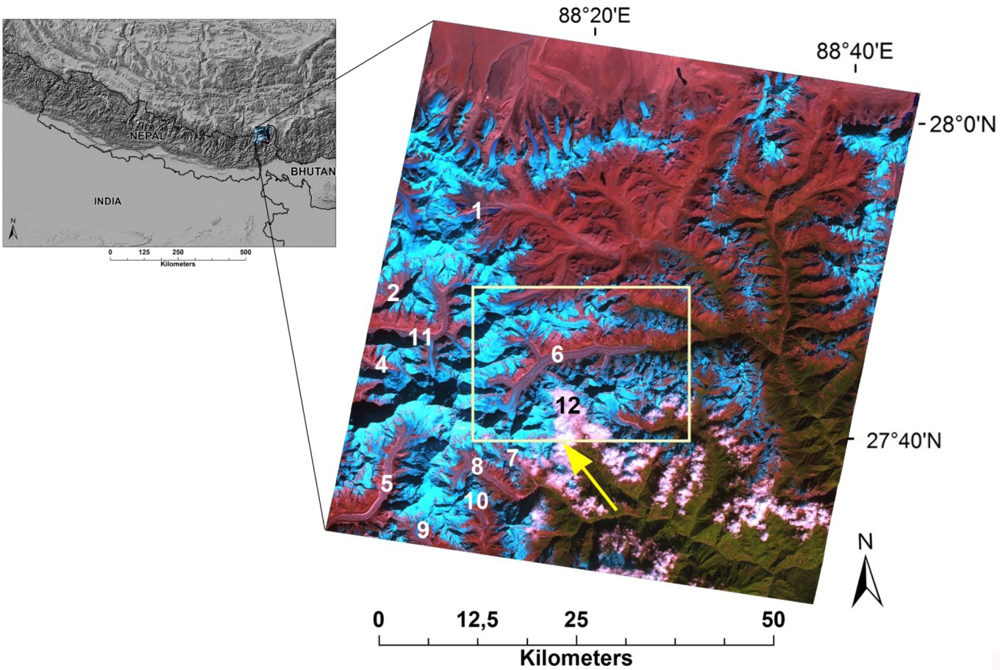

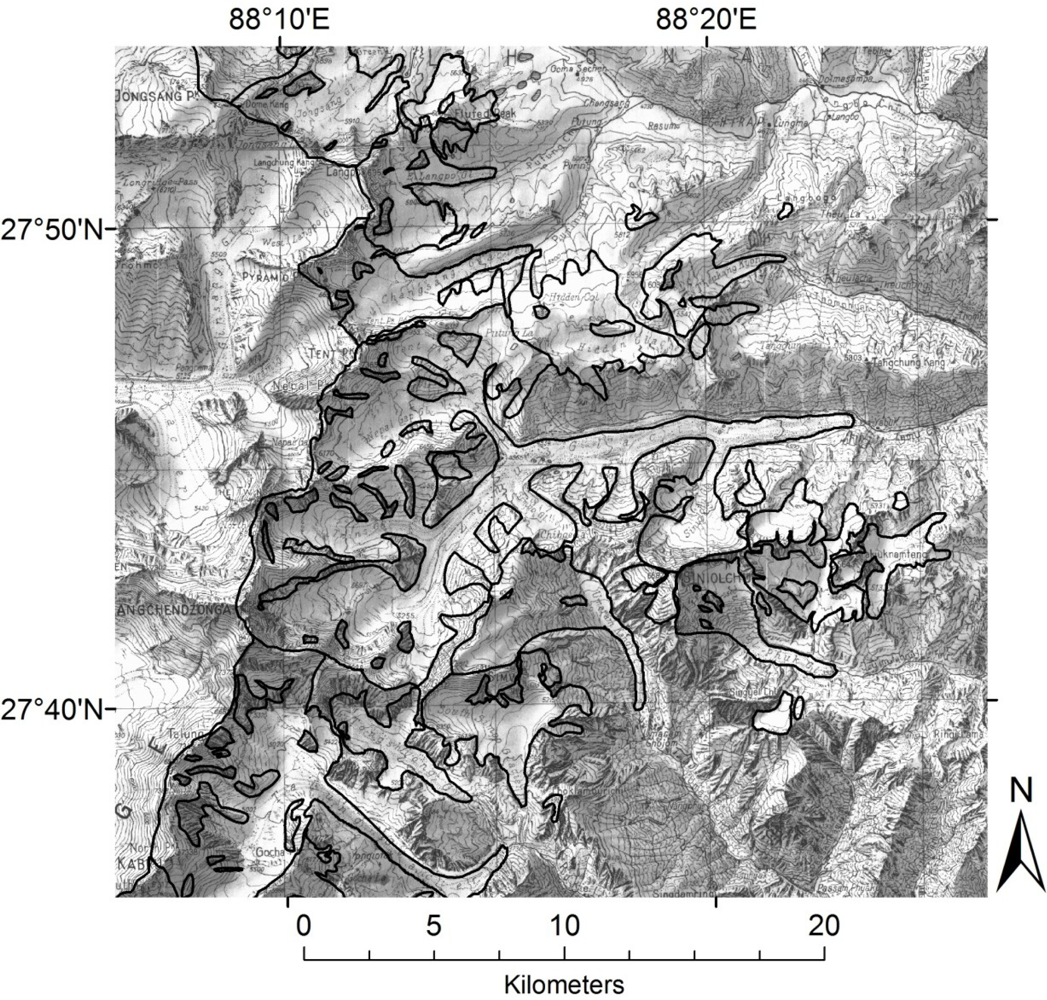

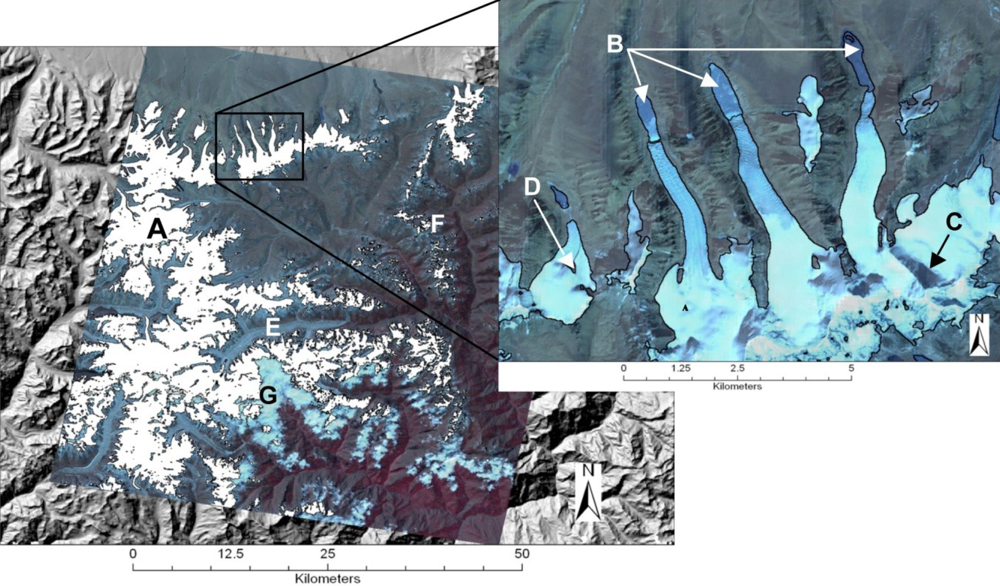
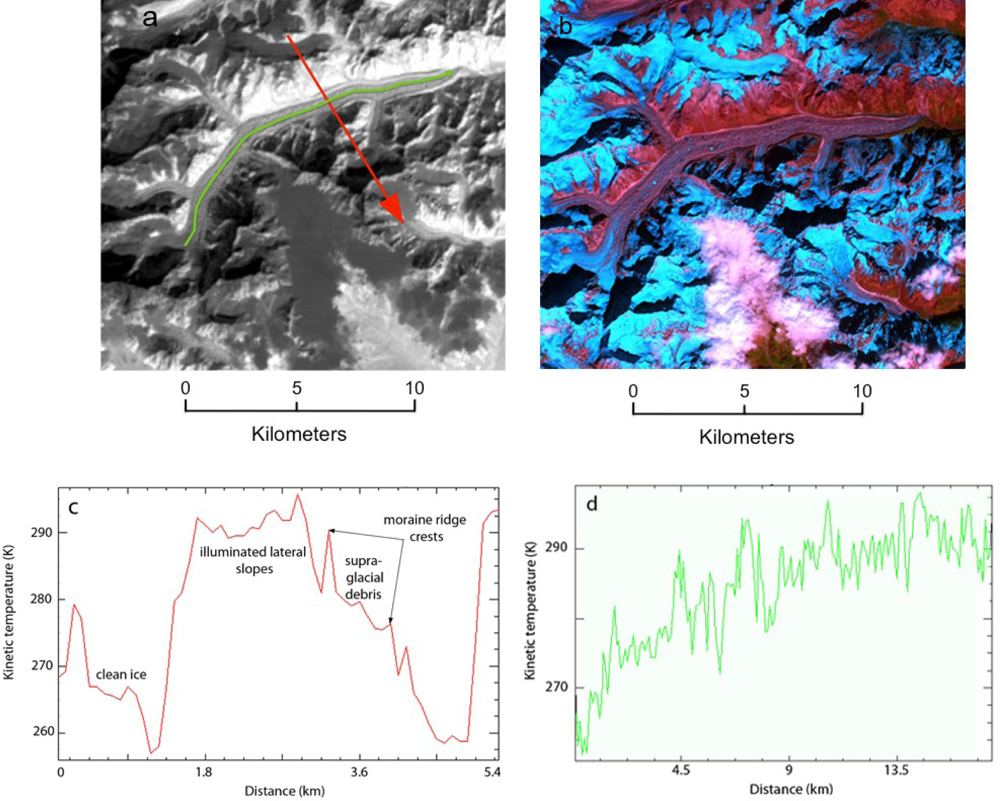
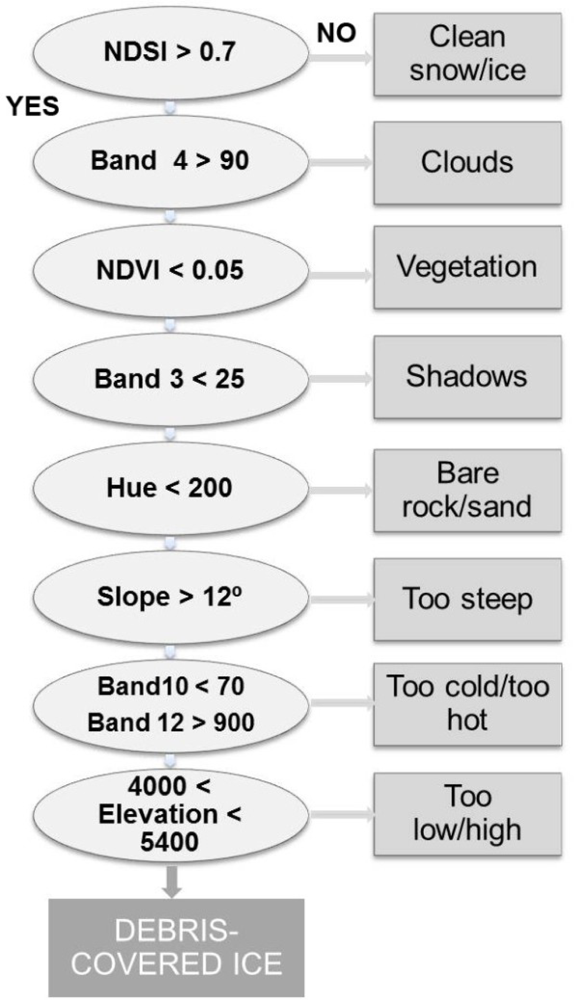
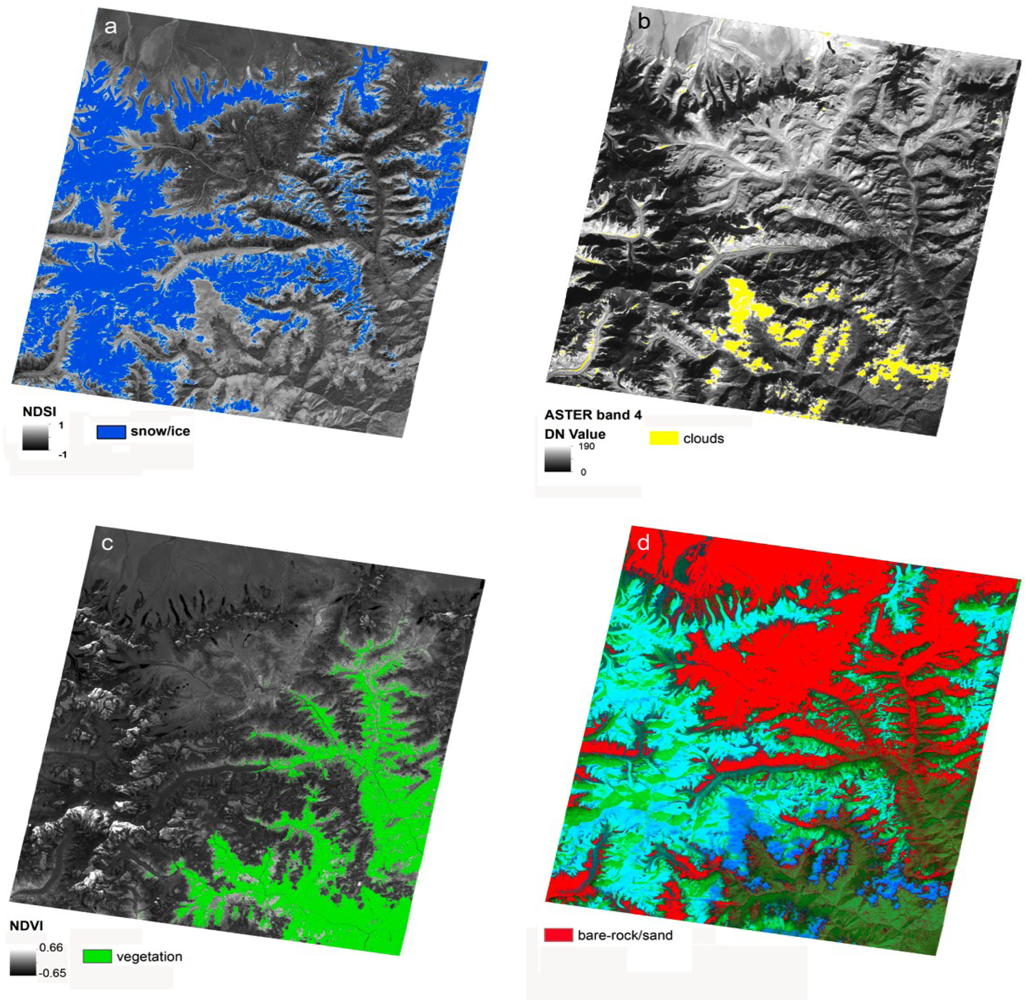
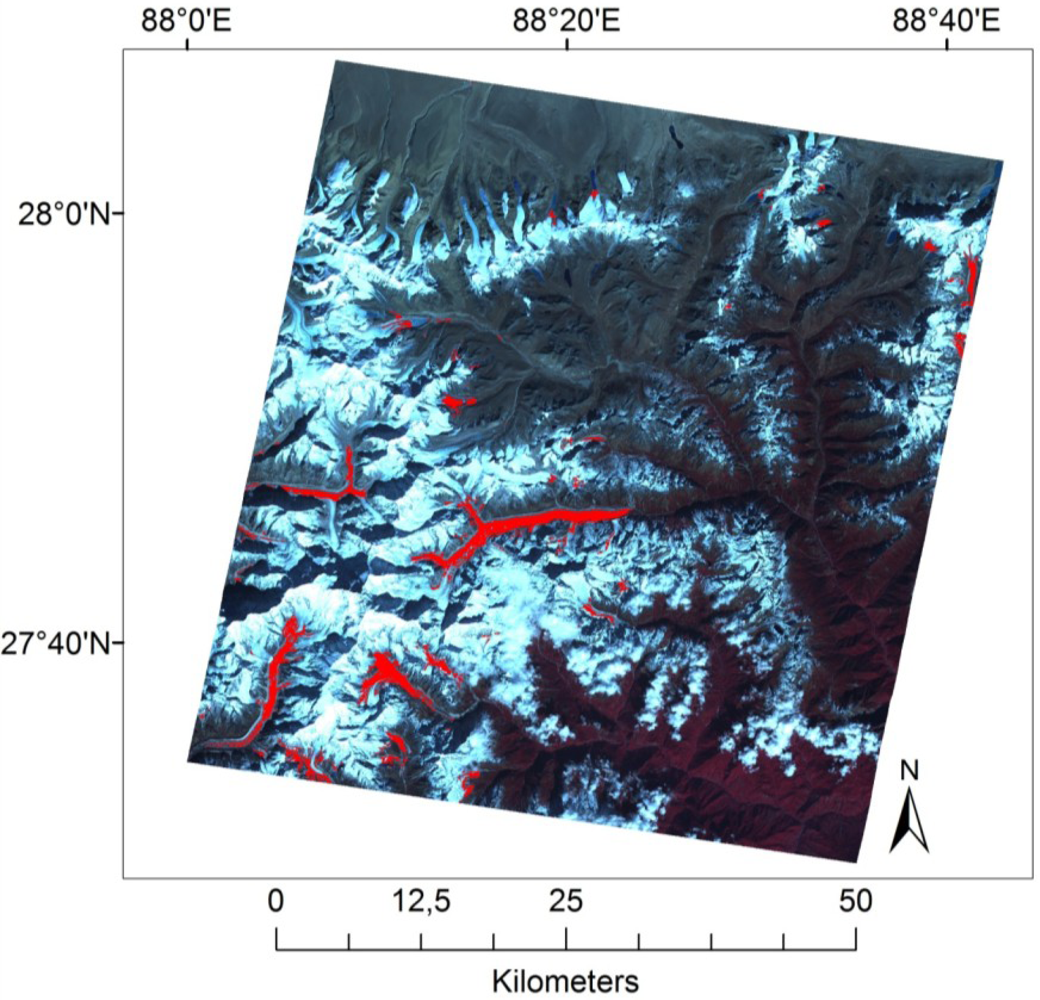

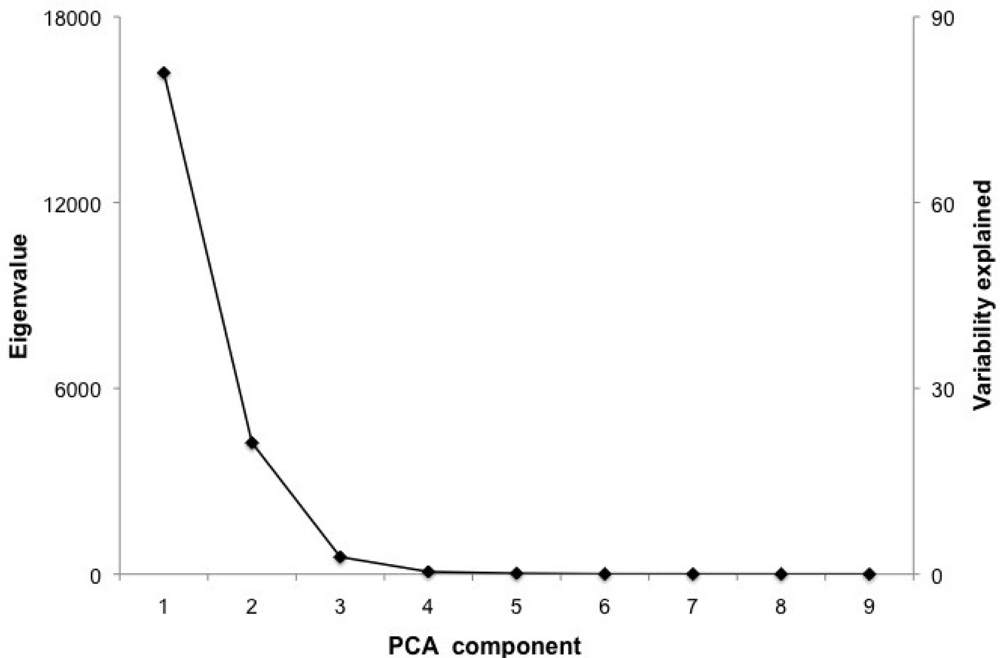

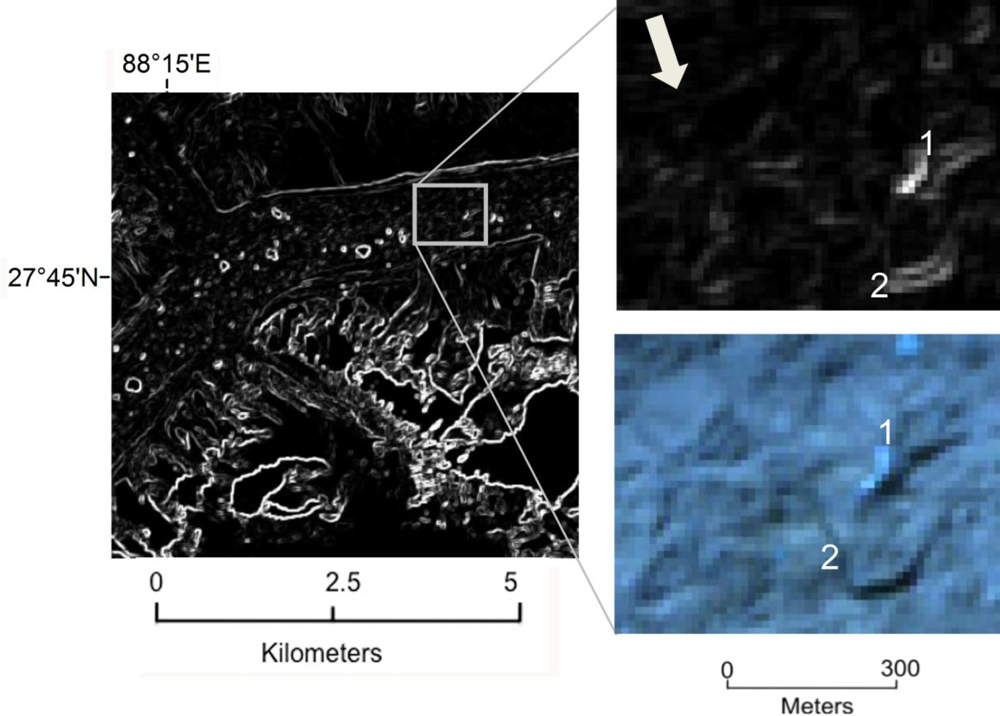
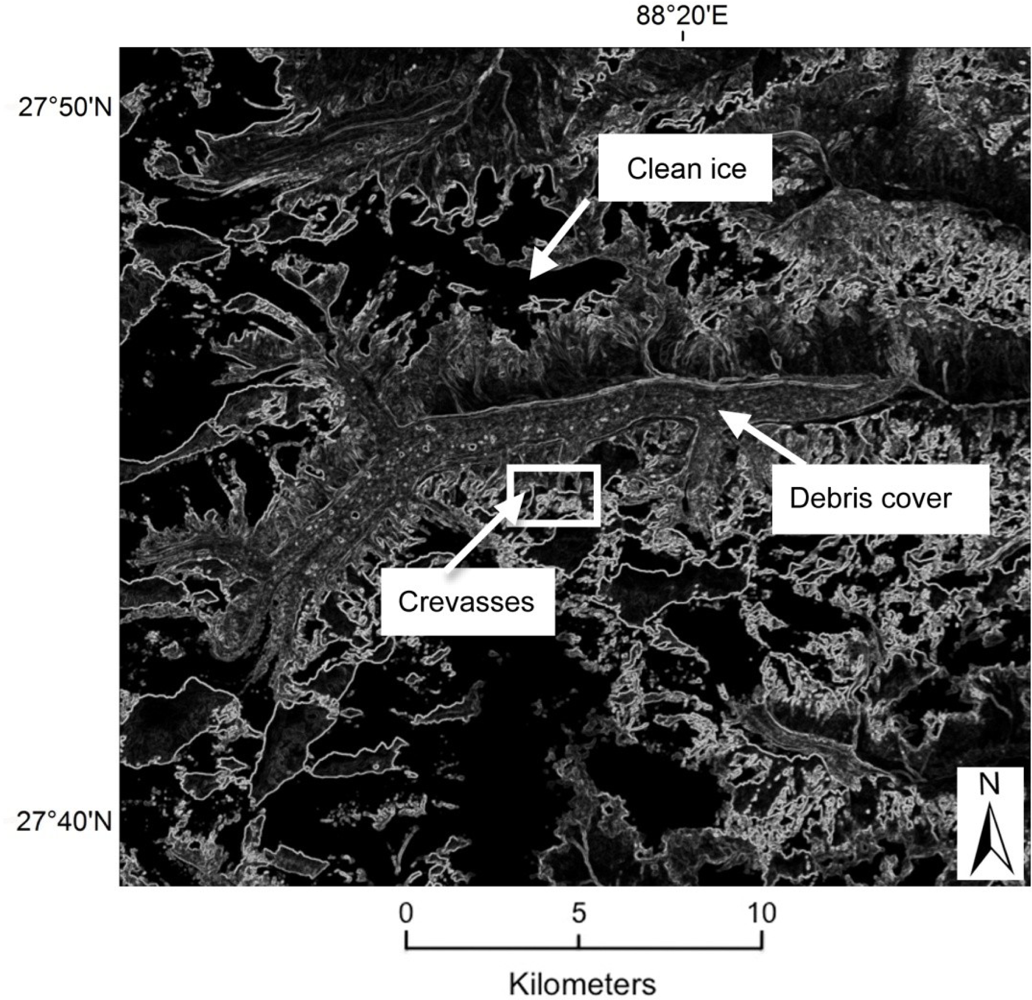

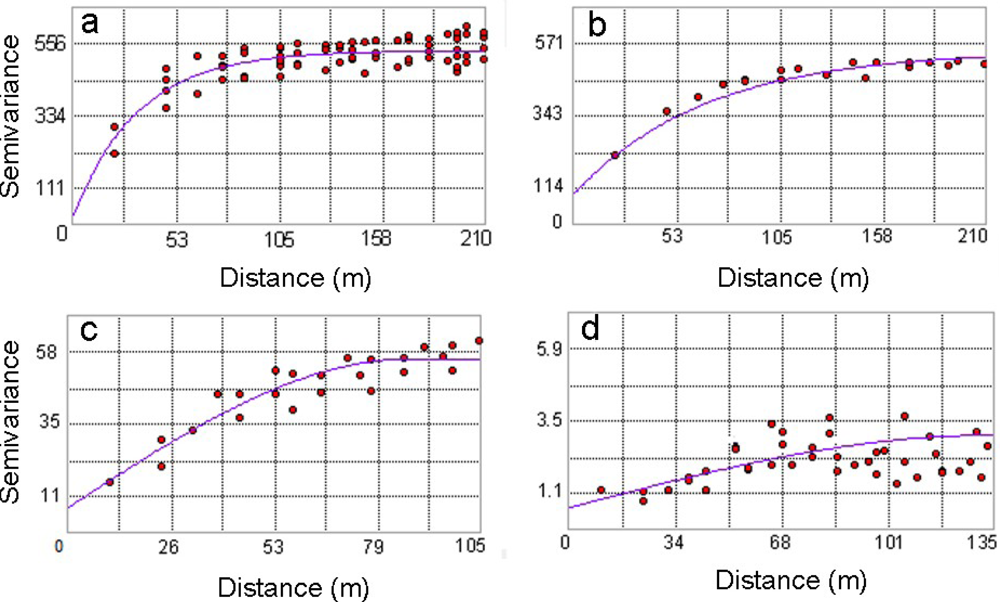
| Source | Scene ID | Date | Spatial Resolution | Notes |
|---|---|---|---|---|
| ASTER | AST14DMO_00311272001045729_20071114145408 | 11-26-2001 | 15 m VIS 30 m SWIR 90 TIR | Some seasonal snow; clouds on the lower part of the image mostly outside glaciers |
| Quickbird | 1010010004BD8700 1010010004BB8F00 | 1-6-2006 1-1-2006 | 2.4 m multispectral | Well contrasted; no clouds; minimal snow |
| WorldView2 | 102001000FBA1D00 | 12-02-2010 | 0.5 m panchromatic | No clouds; good contrast |
| Topographic map | N/A | ∼1960s–1970s | - | Exact date of the source aerial photography unknown; used as a priori knowledge to extract various classes. |
| Criteria | ASTER Bands | Range | Threshold | Justification |
|---|---|---|---|---|
| Snow/ice | NDSI (bands 1 and 4) | 0.72–1 | 0.7 | Reflective in the VIS and less reflective in the NIR |
| Clouds | Band 4 | 76–141 | 90 | Reflective in mid-IR where the reflectivity of snow and ice decreases |
| Vegetation | NDVI (bands 2 and 3) | 0.05–0.56 | 0.05 | Highly reflective in the NIR, less in the VIS |
| Shadows | Band 3 | 2–30 | 25 | Shadows are most distinguishable in band 3, where they have low reflectance values |
| Hue | HSV (bands 235) | 210–258 | 200 | Useful for distinguishing between vegetated and non-vegetated land |
| Slope | ASTER DEM | 0–14 | 12 | Debris-cover tongues generally have gentle slopes |
| Temperature | AST08; bands 10–12 | 272.3–282.8 K | Band 10 > 700 and band 12 < 900 | Debris covered ice generally colder than lateral moraines for thin patchy debris |
| Elevation | ASTER DEM | 4,000–5,400 | 4,000–5,400 | Debris-covered tongues exist between regional minimum termini elevation and below the regional ELA |
| ID | Glacier | 2001 ASTER (Decision Tree) (km2) | 2001 ASTER Texture (Manual) (km2) | Area Difference (Texture-Decision Tree) (km2) | 2006 QB/WV2 (Manual) (km2) |
|---|---|---|---|---|---|
| 1 | S. Lhonak | 0.9 | 1.2 | 0.3 | 0.8 |
| 2 | Broken | 2.6 | 3.0 | 0.4 | 0.2 |
| 3 | E. Langpo | 2.2 | 2.4 | 0.2 | 1.7 |
| 4 | Ramtang | 1.1 | 2.4 | 1.3 | 0.7 |
| 5 | Yalung | 13.2 | 16.9 | 3.7 | 9.0 |
| 6 | Zemu | 24.7 | 24.8 | 0.1 | 20.1 |
| 7 | Tongshuong | 4.0 | 2.2 | −1.8 | 2.2 |
| 8 | Talung | 9.9 | 10.1 | 0.2 | 7.7 |
| 9 | E. Rathong | 2.7 | 3.9 | 1.2 | 3.5 |
| 10 | Onglaktang | 2.9 | 2.9 | 0.0 | 2.0 |
| Total | 64.1 | 69.9 | 5.7 | 47.9 | |
| Clean Ice | Debris Cover | Clouds | Bare Rock/Sand | |
|---|---|---|---|---|
| Variance | 0.06 | 15.27 | 0 | 2.01 |
| Homogeneity | 0.99 | 0.22 | 1 | 0.52 |
| Entropy | 0.01 | 2.13 | 0 | 1.79 |
| Search Direction | Shape | Nugget (m) | Sill (m2) | Range (m) | |
|---|---|---|---|---|---|
| Debris | no | Exponential | 14.4 | 513.6 | 98.7 |
| Debris | yes | Exponential | 90.8 | 457.2 | 201.2 |
| Bare Rock/Sand | no | Exponential | 7.8 | 48.2 | 87 |
| Clean ice | no | Spherical | 0.7 | 2.3 | 132 |
Share and Cite
Racoviteanu, A.; Williams, M.W. Decision Tree and Texture Analysis for Mapping Debris-Covered Glaciers in the Kangchenjunga Area, Eastern Himalaya. Remote Sens. 2012, 4, 3078-3109. https://doi.org/10.3390/rs4103078
Racoviteanu A, Williams MW. Decision Tree and Texture Analysis for Mapping Debris-Covered Glaciers in the Kangchenjunga Area, Eastern Himalaya. Remote Sensing. 2012; 4(10):3078-3109. https://doi.org/10.3390/rs4103078
Chicago/Turabian StyleRacoviteanu, Adina, and Mark W. Williams. 2012. "Decision Tree and Texture Analysis for Mapping Debris-Covered Glaciers in the Kangchenjunga Area, Eastern Himalaya" Remote Sensing 4, no. 10: 3078-3109. https://doi.org/10.3390/rs4103078
APA StyleRacoviteanu, A., & Williams, M. W. (2012). Decision Tree and Texture Analysis for Mapping Debris-Covered Glaciers in the Kangchenjunga Area, Eastern Himalaya. Remote Sensing, 4(10), 3078-3109. https://doi.org/10.3390/rs4103078



